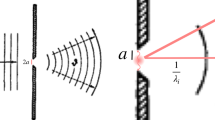Abstract
It is first pointed out that there is a common mathematical model for the universe and the quantum computer. The former is called the histories approach to quantum mechanics and the latter is called measurement-based quantum computation. Although a rigorous concrete model for the universe has not been completed, a quantum measure and integration theory has been developed which may be useful for future progress. In this work we show that the quantum integral is the unique functional satisfying certain basic physical and mathematical principles. Since the set of paths (or trajectories) for a quantum computer is finite, this theory is easier to treat and more developed. We observe that the sum of the quantum measures of the paths is unity and the total interference vanishes. Thus, constructive interference is always balanced by an equal amount of destructive interference. As an example we consider a simplified two-slit experiment.
Similar content being viewed by others
References
Briegel, H., Browne, D., Dür, W., Raussendorf, R., Van der Nest, M.: Measurement-based quantum computation. Nat. Phys. 51, 19–26 (2009)
Dowker, F., Ghazi-Tabatabai, Y.: Dynamical wave function collapse models in quantum measure theory. J. Phys. A 41, 205306 (2008)
Dowker, F., Johnston, S., Sorkin, R.: Hilbert spaces from path integrals (2010). arXiv:1002.0589 [quant-ph]
Gross, D., Eisert, J., Shuch, N., Perez-Garcia, D.: Measurement-based quantum computation beyond the one-way model. Phys. Rev. A 76, 052315 (2007)
Gudder, S.: Quantum measure theory. Math. Slovaca 60, 681–700 (2010)
Gudder, S.: Quantum measure and integration theory. J. Math. Phys. 50, 123509 (2009). arXiv:0909.2203 [quant-ph]
Haliwell, J.J.: Partial decoherence of histories and the Diosi test. arXiv:0904.4388 [quant-ph], and Quant. Info. Proc. (2009, to appear)
Isham, C.: Quantum logic and the histories approach to quantum theory. J. Math. Phys. 35, 2157–2185 (1994)
Jozsa, R.: An introduction to measurement based quantum computation (2009). arXiv:quant-ph/0508124
Martin, X., O’Connor, D., Sorkin, R.: The random walk in generalized quantum theory. Phys. Rev. D 71, 024029 (2005)
Sorkin, R.: Quantum mechanics as quantum measure theory. Mod. Phys. Lett. A 9, 3119–3127 (1994)
Sorkin, R.: Quantum measure theory and its interpretation. In: Feng, D., Hu, B.-L. (eds.) Proceedings of the 4th Drexel Symposium on Quantum Nonintegrability, pp. 229–251 (1994)
Sorkin, R.: Quantum mechanics without the wave function. J. Phys. A 40, 3207–3231 (2007)
Author information
Authors and Affiliations
Corresponding author
Rights and permissions
About this article
Cite this article
Gudder, S. The Universe and the Quantum Computer. Int J Theor Phys 50, 3800–3811 (2011). https://doi.org/10.1007/s10773-011-0667-4
Received:
Accepted:
Published:
Issue Date:
DOI: https://doi.org/10.1007/s10773-011-0667-4




